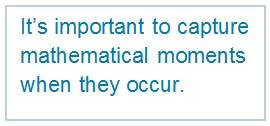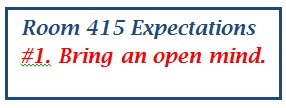Sara Liebert teaches in San Francisco USD. My friend Lynne Zolli and I have worked on several math projects together over the years, and Sara’s class is one we use to try out ideas with students. On Monday, Lynne led an activity with the class as a way to introduce herself and also to support Sara’s expectation for her students to come to class with open minds.
Lynne wrote twelve numbers on the board and asked the students to “open their minds” and tell her anything they noticed. (Lynne chose numbers that she knew had a variety of relationships among them.)
1 2 4 5 9 10 16 25 36 49 50 100
As students suggested ideas, Lynne recorded them on the board and then had others find examples from the numbers on the board. The students had a range of ideas.
- Some of the numbers are odd and some are even.
Odd: 1, 5, 9, 25, 49 Even: 2, 4, 10, 16, 36, 50, 100
- Some numbers are doubles of others.
4 is the double of 2, 10 of 5, 50 of 25, 100 of 50
- You can add some numbers to get others.
4 + 5 = 9, 1 + 4 + 5 = 10, 1 + 9 = 10, 9 + 16 = 25, 1 + 49 + 50 = 100
- Some are “money” numbers because they are coins.
1 cent is a penny, 5 cents is a nickel, 10 is a dime, 25 is a quarter, 100 is a dollar
- You can use some numbers to make up subtraction problems.
10 – 1 = 9, 10 – 9 = 1, 50 – 1 = 49, 50 – 49 = 1, 25 – 9 = 16, 25 – 16 = 9
- There are multiplication problems.
2 x 5 = 10, 5 x 10 = 50, 2 x 25 = 50
- There are other multiplication problems where you multiply one of the numbers by itself and get another in the list.
2 x 2 = 4, 4 x 4 = 16, 5 x 5 = 25, 10 x 10 = 100
Because they noticed these, Lynne decided to slip in introducing the symbol for using the exponent of 2. She wrote on the board:
2 x 2 = 4
22 = 4
She pointed to 22 and explained, “This means to multiply 2 by itself. You read it as two squared equals four or two to the second power equals four.” Lynne then wrote on the board:
4 x 4 = 16
42 = 16
She pointed to 42 and explained, “This means to multiply 4 by itself. You read it as four squared equals sixteen or four to the second power equals sixteen.” Lynne presented 52 = 25 and 102 = 100 in the same way, now having the students read the equations aloud along with her.
A Mathematical Moment
A girl then raised her hand and asked, “What would happen if I put a little 3 where the little 2 goes?” That was a wonderful mathematical  moment. Lynne asked her what she thought it meant. “I think it maybe means that you multiply the number three times,” she responded. Lynne confirmed that she was correct, wrote on the board 23 = 2 x 2 x 2, and asked her to figure the answer.
moment. Lynne asked her what she thought it meant. “I think it maybe means that you multiply the number three times,” she responded. Lynne confirmed that she was correct, wrote on the board 23 = 2 x 2 x 2, and asked her to figure the answer.
Introducing Another Context
To have them think about these numbers in a context other than money, Lynne asked the students for a number on the list that made sense for the temperature in San Francisco. They decided on 50 and she asked them if they knew the symbol for degrees and where she could write it. Some did and some didn’t. Lynne wrote on the board: 50 o.
Final Thoughts
When I shared with Lynne how I described the lesson, Lynne responded with several comments. She wrote: I feel that it’s very important to capture mathematical moments when they occur, things that weren’t planned but that arise spontaneously. As an example, I hadn’t planned or anticipated introducing exponents in this warm-up experience, but the opportunity came from what the students noticed. Also, the girl wondering about using a “little 3” in place of the exponent 2 was another wonderful mathematical moment.
Lynne also wrote: There are many other ways to think about constructing a list of numbers for an exploration like this. I could include greater numbers, including some in the hundreds and thousands. I could introduce fractions informally by including numbers that represent halves―1/2, 2/4, 50/100, and so on. I could include a mix of whole numbers, fractions, and decimals. The more I think about this activity, more ideas keep coming.
Lynne offered a last comment: It points out to me that the importance of being flexible when teaching to expand on what the students bring forth. Also, if the students don’t come up with ideas, I’m ready to suggest connections to encourage their thinking.
A Comment from Sara
It was so fun to watch Lynne lead that lesson. She was able to engage some students who, up to this point, have not engaged in a math talk. Plus, just watching how the room turned into a lab of students trying to think about numbers was so enjoyable! Sometimes, we need to step back and watch our students to appreciate them even more.


I do “Number Talks” with my students, and I appreciate how students explain their thinking. This particular lesson really “opens students’ minds”. I love the spontaneity at so many different levels. This activity is one that I will use with my students in so many ways! Thank you for sharing. It is indeed important to capture mathematical moments when they occur.
This reminds me of when I was teaching high school algebra and one day was sharing something from a book titled something like “Exciting Mathematical Moments” (don’t remember the exact title now). Anyway, the class began to snicker and I asked what was so funny and someone pointed out that the idea of an “exciting” mathematical moment was impossible. It wasn’t in their realm of imagination. This led to an engaging discussion of how one feels when a “lightbulb” comes on in one’s mind and I said that I could tell when one of them was having a mathematical moment by the light in their eyes, expression on their face. Long story short this became a focus in the class from there on. I would occasionally say, “Sally, are you having a mathematical moment?” or would be thrilled when a student would suddenly call out, “I’m having a mathematical moment!” I love the focus on open minds here that led to the unexpected introduction of exponents. It was a great mathematical moment. Providing students that opportunity is vital.
Makes my heart warm to hear “because they had noticed…” — so much better than “we have to get through the text…”
I love that, “What would happen if I put a little 3 where the little 2 goes?”!
“I feel that it’s very important to capture mathematical moments when they occur, things that weren’t planned but that arise spontaneously.” I love this! Many times our lessons are over-structured and too rigid which doesn’t allow the opportunity to invite the mathematical moments.
I facilitated this talk today in a 4th grade classroom where there is reluctance to share. The sharing included consecutive numbers, odd/even, number of digits and definition of “digit”, and some adding. I mentioned that I felt there was some “reluctance” to share ideas … that I had seen written in math journals. At the end of the talk, I asked students to go back to their journals and record something new they were thinking about and/or record an idea on the chart. Ryan wrote this: “Reluctant means you don’t want to talk and when you don’t talk we can’t hear your awesome ideas and they could be right.” I recorded that statement on the chart. It will be referenced often in the classroom. Aahhhh….kids!